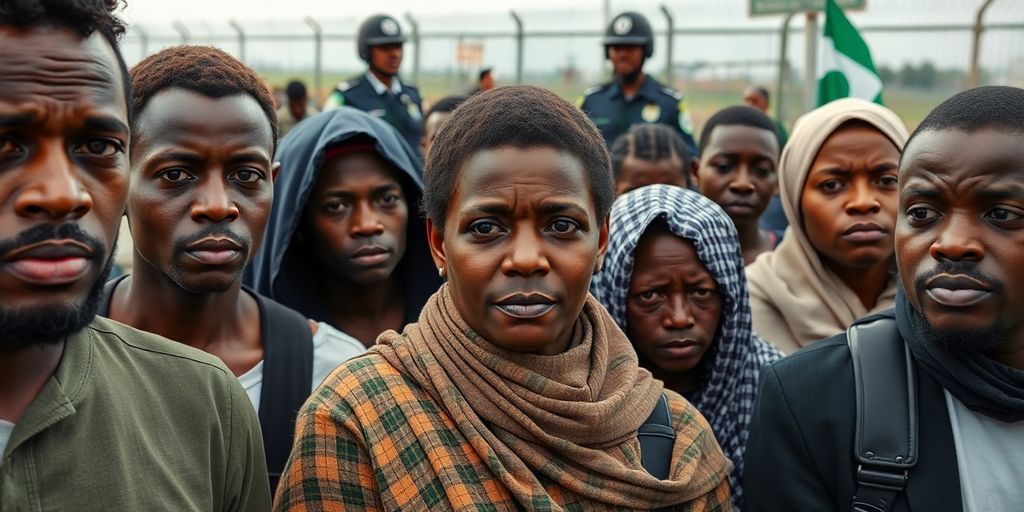In recent years, U.S. border policies have come under intense scrutiny, with many arguing that they reflect a troubling pattern of unfairness, particularly towards Nigerian immigrants. This article explores the complexities of these policies, examining their historical context, the impact of the Trump administration’s travel ban, and the ongoing disparities in immigration enforcement. As we delve into personal stories and legal ramifications, we aim to uncover the ethical implications of these policies and the political motivations that may drive them. Ultimately, we ask: Are U.S. border policies exhibiting double standards when it comes to Nigerians?
Key Takeaways
- U.S. border policies have evolved significantly over the decades, often influenced by historical prejudices.
- The Trump administration’s travel ban expanded restrictions on several African nations, including Nigeria, raising concerns about discrimination.
- Immigration enforcement often targets specific nationalities, highlighting disparities in how different groups are treated.
- Personal accounts from Nigerians affected by these policies reveal the profound human impact of restrictive immigration laws.
- Public perception of immigration is shaped by media narratives and misinformation, complicating the conversation around fairness in border policies.
Historical Context Of US Border Policies
The Evolution Of Immigration Laws
Okay, so when we talk about US border policies, we can’t just jump into the present day. We have to rewind a bit. The story of immigration laws here is a long and winding one, full of twists and turns. Early laws were pretty open, honestly. Think back to the 18th and 19th centuries – the US needed people! But as the country grew, so did the restrictions. The Chinese Exclusion Act of 1882? A huge turning point. It showed that the US wasn’t always welcoming to everyone. Then came quotas based on nationality in the early 20th century. It’s a history of shifting priorities and, frankly, a lot of prejudice. Understanding this evolution is key to seeing how we got where we are today. It’s not a straight line; it’s more like a tangled web. The Immigration and Nationality Act of 1952, also known as the McCarran-Walter Act, is another example of early immigration laws that shaped the landscape.
Key Events Shaping Current Policies
There are definitely some big moments that have shaped the border policies we have now. 9/11, without a doubt, changed everything. Suddenly, border security became a top priority, and we saw a huge increase in funding and new agencies popping up. The creation of the Department of Homeland Security? A direct result. But it’s not just about security. Economic recessions have played a role too. When times are tough, you often see increased anti-immigrant sentiment and calls for stricter enforcement. And then there are specific pieces of legislation, like the Immigration Reform and Control Act of 1986, which tried to address undocumented immigration but also had some unintended consequences. It’s a mix of security concerns, economic anxieties, and political maneuvering that has shaped the landscape. The Trump administration’s policies also had a significant impact, as detailed in "Dismantling and Reconstructing".
Impact Of Historical Prejudices
Let’s be real: historical prejudices have had a massive impact on US border policies. It’s not always obvious, but if you dig a little, you can see how biases against certain groups have influenced who gets in and who doesn’t. Think about the way different nationalities have been treated over time. Some groups have faced much tougher scrutiny and higher barriers than others. This isn’t just about individual attitudes; it’s about systemic biases that have been baked into the laws and regulations themselves. And it’s not just about race; it’s also about religion, national origin, and even political ideology. We need to acknowledge this history if we want to create a fairer system. Ignoring it just perpetuates the same old patterns.
It’s important to remember that these policies don’t exist in a vacuum. They’re the result of decisions made by people, often with their own biases and agendas. Understanding this human element is crucial to understanding the policies themselves.
Here are some examples of how historical prejudices have impacted border policies:
- The Chinese Exclusion Act of 1882, which barred Chinese laborers from entering the country.
- The National Origins Formula, which favored immigrants from Northern and Western Europe.
- The ongoing debates about immigration from Latin America, often fueled by racial and ethnic stereotypes.
The Trump Administration’s Travel Ban
Overview Of The Travel Ban
The Trump administration’s travel ban, officially initiated with Executive Order 13769, aimed to restrict entry into the United States from several countries. It was presented as a measure to enhance national security, citing concerns about vetting procedures in the designated nations. The initial ban, issued in January 2017, faced immediate backlash and legal challenges, leading to revised versions. The core argument was the need to protect the US from potential terrorist threats, although critics argued it was discriminatory and lacked evidence-based justification. The policy evolved through several iterations, each facing scrutiny and legal battles.
Countries Affected By The Ban
The list of countries subject to the travel ban varied over time, but it predominantly included nations with majority-Muslim populations. Initially, the ban targeted Iran, Iraq, Libya, Somalia, Sudan, Syria, and Yemen. Subsequent versions removed Iraq but added others, including North Korea and Venezuela (though the restrictions on Venezuela were limited to government officials and their families). In 2020, the ban was expanded to include Nigeria, Sudan, Tanzania, Eritrea, Myanmar, and Kyrgyzstan, albeit with some differences in the types of visas affected. For example, the 2020 expansion did not affect nonimmigrant visas. The inclusion of Nigeria, Africa’s most populous nation, sparked significant controversy and raised questions about the motivations behind the policy.
Public Reaction And Legal Challenges
The travel ban triggered widespread protests and condemnation both domestically and internationally. Civil rights organizations, advocacy groups, and legal scholars challenged the ban in court, arguing that it violated the Establishment Clause of the First Amendment and the Equal Protection Clause of the Fourteenth Amendment. The legal challenges resulted in numerous court injunctions and appeals, ultimately reaching the Supreme Court. Public reaction was sharply divided, with supporters arguing that the ban was a necessary security measure and opponents decrying it as discriminatory and un-American. The intense debate highlighted deep divisions within American society regarding immigration, national security, and religious freedom.
The travel ban was more than just a policy; it became a symbol of the broader debate over immigration and national identity in the United States. It raised fundamental questions about who is welcome in America and what values the nation should uphold.
Here’s a summary of the legal challenges:
- Initial lawsuits filed immediately after the first ban.
- Multiple injunctions issued by lower courts.
- Supreme Court rulings upholding revised versions of the ban.
Disparities In Immigration Enforcement
Targeting Of Specific Nationalities
It’s hard to ignore the data suggesting that immigration enforcement isn’t applied evenly. Some nationalities appear to face higher scrutiny and deportation rates than others. This raises serious questions about whether implicit biases are at play within our system. Are certain groups unfairly targeted? It’s a complex issue, but one we must confront head-on.
Comparative Analysis With Other Countries
When we look at how the US handles immigration compared to other nations, some stark differences emerge. For example, some European countries prioritize integration programs and offer more pathways to citizenship. The US system, in contrast, often emphasizes enforcement and border security. This comparative lens helps us see potential areas for improvement and alternative approaches.
Here’s a simplified comparison:
| Country | Focus | Integration Support |
|---|---|---|
| US | Enforcement | Limited |
| Canada | Skilled Workers | High |
| Germany | Asylum Seekers | Moderate |
The Role Of Rhetoric In Policy
The language used by politicians and the media significantly shapes public perception and, ultimately, policy. Inflammatory rhetoric can create a climate of fear and hostility towards immigrants, leading to stricter enforcement measures. It’s crucial to examine how border arrests are framed and whether that framing contributes to disparities in enforcement.
We need to be mindful of the power of words. The way we talk about immigration influences how we treat immigrants. It’s a responsibility we all share to promote fair and accurate narratives.
The Human Impact Of Border Policies
Personal Stories From Affected Nigerians
Hearing directly from individuals impacted by border policies offers a stark contrast to abstract legal discussions. I’ve come across accounts of families separated, dreams deferred, and lives placed on hold indefinitely. These aren’t just statistics; they’re people with hopes, fears, and the fundamental desire for a better life. One story that sticks with me is about a Nigerian doctor, trained and ready to contribute to the US healthcare system, who faced endless delays and bureaucratic hurdles, ultimately leading to a sense of profound disillusionment. These personal narratives highlight the very real consequences of policies that, on paper, might seem detached from human experience. It’s easy to forget the human element when discussing immigration, but these stories serve as a powerful reminder of the stakes involved.
Mental Health Consequences
The stress and uncertainty associated with navigating complex immigration systems can take a significant toll on mental well-being. The fear of deportation, the anxiety of waiting for decisions, and the sense of being unwelcome can lead to depression, anxiety, and other mental health issues. The psychological impact is often overlooked in policy debates, but it’s a critical aspect of the human cost. I’ve read studies showing a direct correlation between restrictive immigration policies and increased rates of mental health problems among immigrant communities. It’s a silent crisis that demands attention and resources. The mental health consequences are real and lasting.
Community Responses And Support
In the face of these challenges, communities often rally to provide support and assistance. Grassroots organizations, religious institutions, and individual volunteers step in to offer legal aid, emotional support, and practical assistance to those affected by border policies. These networks of solidarity are a testament to the resilience and compassion of the human spirit. I’ve seen examples of communities organizing workshops to educate immigrants about their rights, providing safe spaces for them to share their experiences, and advocating for policy changes that would create a more just and humane system. It’s inspiring to witness the power of collective action in the face of adversity. The Trump administration’s travel ban had a huge impact on communities.
It’s important to remember that behind every policy decision, there are real people whose lives are profoundly affected. The human impact of border policies is not just an abstract concept; it’s a lived reality for countless individuals and families.
Here are some ways communities are helping:
- Providing legal assistance
- Offering language classes
- Creating support groups
Legal Ramifications Of Border Policies
Understanding Asylum Laws
Asylum laws are designed to protect individuals fleeing persecution in their home countries. However, the application and interpretation of these laws can be complex. Navigating the asylum process often requires a deep understanding of international and domestic laws, as well as the ability to present a compelling case that demonstrates a well-founded fear of persecution. The burden of proof lies with the applicant, and the process can be lengthy and emotionally taxing.
Challenges Faced By Immigrants
Immigrants face numerous legal challenges when dealing with US border policies. These can include:
- Language barriers, which make it difficult to understand legal documents and procedures.
- Lack of access to legal representation, leaving many to navigate the system alone.
- Detention, which can limit access to resources and support networks.
- Complex and ever-changing immigration laws, which can be difficult to understand even for legal professionals.
The legal system can be incredibly intimidating, especially when you’re facing deportation or separation from your family. It’s a system that often feels stacked against immigrants, with long delays, confusing paperwork, and a constant threat of being sent back to a place where they may face danger.
Recent Court Rulings
Recent court rulings have significantly impacted US border policies. Some decisions have challenged the legality of certain enforcement practices, while others have upheld the government’s authority to regulate immigration. These rulings often set precedents that shape future policy and legal challenges. For example, a new visa restriction policy could face legal challenges. It’s important to stay informed about these developments, as they can have a direct impact on the lives of immigrants and their families.
Public Perception Of Immigration
Media Representation Of Nigerian Immigrants
How Nigerians are shown in the news and entertainment can really shape what people think. If the stories are mostly about crime or problems, that’s going to create a negative image. On the other hand, if there are stories about successful Nigerian professionals or cultural contributions, that could help change minds. It’s a complex thing, but the media definitely plays a big role in shaping public opinion.
Shifts In Public Opinion
Public opinion on immigration isn’t set in stone; it changes over time. Things like the economy, political events, and even global events can all have an impact. For example, if the economy is doing well, people might be more open to immigration. But if there’s a recession, they might worry about jobs. It’s also worth noting that different groups of people have different views. Here are some factors that influence shifts in public opinion:
- Economic conditions
- Political climate
- Social events
The Role Of Misinformation
Misinformation can really mess things up. If people believe false things about immigrants, it can lead to prejudice and bad policies. It’s important to get the facts straight and challenge false narratives. Rumors spread fast, especially online, and they can be hard to correct. It’s up to all of us to be critical thinkers and share accurate information.
It’s easy to see how easily people can be misled. When people are scared or uncertain, they’re more likely to believe things without checking them out. That’s why it’s so important to have reliable sources of information and to be willing to question what we hear.
Political Motivations Behind Border Policies
Influence Of Political Parties
Political parties often shape border policies to align with their core ideologies and voter bases. For example, parties emphasizing national security might advocate for stricter border controls, while others may prioritize humanitarian concerns and push for more lenient policies. It’s a constant tug-of-war, and the resulting policies often reflect a compromise—or a complete victory—for one side. Understanding these influences is key to grasping the underlying motivations behind immigration laws.
Lobbying And Special Interests
Lobbying groups and special interests play a significant role in shaping border policies. These groups, representing various industries and advocacy organizations, exert influence through campaign contributions, direct lobbying, and public relations efforts. Their motivations can range from economic gains to ideological goals, and their impact on policy decisions is undeniable. It’s not always a transparent process, which can lead to policies that benefit a select few rather than the broader public. U.S. assistance can be affected by these influences.
The Intersection Of Race And Policy
Race has historically played a significant role in shaping immigration policies in the United States. From the Chinese Exclusion Act to the national origin quotas of the early 20th century, discriminatory practices have been embedded in the legal framework. Even today, concerns persist that certain border policies disproportionately target specific racial or ethnic groups. Examining this intersection is crucial for understanding the full impact of these policies.
It’s important to acknowledge that the political motivations behind border policies are complex and multifaceted. They involve a combination of ideological beliefs, economic interests, and historical biases. By understanding these factors, we can better evaluate the fairness and effectiveness of these policies and advocate for meaningful change.
Comparative Analysis Of Immigration Policies
US Policies Versus European Approaches
When we look at how the US handles immigration compared to Europe, some big differences jump out. The US system often focuses on family reunification and skills-based immigration, while many European countries have historically emphasized labor migration, though this is changing. One key thing to note is the scale; the US has a much larger undocumented population than most European nations. Also, the legal frameworks differ significantly. For example, the US has a more established system for asylum claims, but European countries often have more comprehensive social support programs for immigrants. It’s not a simple case of one being better than the other; each approach has its own strengths and weaknesses, and both are constantly evolving.
Lessons From Other Nations
There’s a lot the US could learn from other countries’ immigration policies. Canada’s points-based system, for instance, is often praised for its transparency and ability to attract skilled workers. Germany’s approach to integrating Syrian refugees, while facing challenges, offers insights into how to manage large-scale influxes of people. Australia’s strict border control policies, though controversial, have been effective in deterring irregular migration. It’s not about copying these policies wholesale, but rather understanding what works and what doesn’t in different contexts. We can look at immigration policy in other countries to see what works.
The Global Context Of Immigration
Immigration isn’t just a national issue; it’s a global phenomenon driven by factors like economic inequality, conflict, and climate change. Understanding this broader context is crucial for developing effective and humane immigration policies. We need to recognize that people don’t just move for no reason; they’re often fleeing desperate situations or seeking better opportunities for themselves and their families. Ignoring this reality leads to policies that are not only ineffective but also morally questionable. The US, as a global leader, has a responsibility to approach immigration with a sense of empathy and a commitment to international cooperation.
Immigration is a complex issue with no easy answers. It requires a nuanced understanding of the economic, social, and political factors that drive migration, as well as a willingness to engage in open and honest dialogue about the challenges and opportunities it presents.
Here are some factors that influence global immigration:
- Economic disparities between countries
- Political instability and conflict
- Environmental degradation and climate change
Advocacy And Activism For Change
Grassroots Movements In The US
I’ve noticed a surge in grassroots movements across the US, all pushing for changes in immigration policy. These aren’t your typical top-down organizations; they’re groups of everyday people, often directly affected by the policies they’re fighting against. They organize protests, start petitions, and flood social media with stories that humanize the immigration debate. Their strength lies in their authenticity and their ability to mobilize quickly.
Role Of Nonprofits And NGOs
Nonprofits and NGOs play a vital role in advocating for immigrants’ rights. They provide legal assistance, offer resources for newly arrived immigrants, and lobby for policy changes at the local, state, and federal levels. Many focus on providing direct services, like language classes and job training, while others concentrate on advocacy and public education. It’s a diverse ecosystem, all working towards a more just and equitable system. The ACLU shares powerful narratives highlighting the experiences of immigrants.
Success Stories Of Advocacy
It’s easy to feel discouraged when facing seemingly insurmountable challenges, but there have been some real wins thanks to advocacy efforts. Here are a few examples:
- Successful campaigns to stop deportations of long-term residents.
- Increased funding for legal aid services for immigrants.
- Changes in local policies to protect immigrant communities from discrimination.
Advocacy is a marathon, not a sprint. It requires persistence, collaboration, and a deep commitment to justice. Even small victories can have a significant impact on the lives of individuals and communities.
Future Directions For US Border Policy
Potential Reforms On The Horizon
Okay, so, what’s next for US border policy? It’s a big question, and honestly, there are a lot of different ways things could go. One thing I’m keeping an eye on is the push for more comprehensive immigration reform. We’ve been talking about it for years, but maybe, just maybe, we’ll see some movement.
- Modernizing our visa system could help a lot.
- Creating clearer pathways to citizenship for undocumented immigrants already here seems like a no-brainer.
- Investing in smarter border technology, rather than just building walls, could be more effective.
Impact Of Upcoming Elections
Elections, elections, elections. They always change everything, right? The upcoming elections will definitely play a huge role in shaping border policy. Depending on who wins, we could see a complete reversal of current policies or a continuation of the status quo. It’s all about who controls Congress and the White House. I’m watching closely to see how the different parties are positioning themselves on immigration issues. The new administration is expected to focus heavily on border enforcement and limiting the influx of asylum-seekers, indicating a shift towards stricter immigration policies.
The Role Of International Relations
Immigration isn’t just a domestic issue; it’s deeply tied to our relationships with other countries. What happens in Central America, for example, directly affects what happens at our southern border. We need to work with other nations to address the root causes of migration, like poverty and violence.
It’s about finding solutions that benefit everyone, not just us. Ignoring the international dimension of immigration is like trying to fix a leaky faucet without turning off the water – it’s just not going to work.
And honestly, that’s where I think we need to focus our energy. It’s not easy, but it’s the right thing to do.
The Ethical Implications Of Border Policies
Human Rights Considerations
When we talk about border policies, it’s easy to get lost in the details of laws and regulations. But at the heart of it all, we’re dealing with human lives. I believe it’s vital to consider whether our policies align with basic human rights. Are we treating people with dignity, regardless of their origin or status? It’s a question that should guide every decision we make. The NO BAN Act is a step in the right direction.
Moral Responsibility Of Nations
Do nations have a moral duty to help those in need, even if they aren’t citizens? It’s a tough question, and there are many different viewpoints. Some argue that a nation’s primary responsibility is to its own citizens. Others believe that we have a broader obligation to humanity. I think it’s a conversation we need to have openly and honestly. It’s not just about what’s legal, but what’s right. The impact of border policies is significant.
The Debate Over Sovereignty Versus Compassion
It often feels like we’re caught between two opposing forces: a nation’s right to control its borders and our compassion for those seeking a better life. Is it possible to balance these two? Some say that strict border control is essential for national security and economic stability. Others argue that we should prioritize compassion and offer refuge to those fleeing persecution or hardship. I think the answer lies in finding a middle ground – policies that are both effective and humane.
It’s easy to get caught up in the political rhetoric surrounding immigration. But at the end of the day, we’re talking about real people with real stories. We need to remember that every policy decision has a human impact, and we should strive to create a system that is fair, just, and compassionate.
Here are some things to consider:
- The long-term effects of family separation.
- The psychological toll of detention.
- The economic consequences of excluding immigrants.
Final Thoughts
In wrapping up, it’s clear that the U.S. border policies have stirred up a lot of emotions and concerns, especially among Nigerian immigrants. The recent changes seem to hit harder on certain communities, raising questions about fairness and equality. Many Nigerians, who come here seeking safety and a better life, find themselves facing barriers that feel unjust. It’s not just about numbers or policies; it’s about real people with dreams and hopes. As we move forward, it’s crucial to keep these human stories in mind and push for a system that treats everyone with dignity and respect.
Frequently Asked Questions
What are the main reasons behind U.S. border policies targeting Nigerians?
U.S. border policies have often been influenced by political decisions, security concerns, and historical biases, which can lead to specific countries, like Nigeria, facing stricter immigration rules.
How did the Trump administration affect Nigerian immigrants?
The Trump administration expanded the travel ban to include Nigeria, which made it harder for Nigerians to get visas and enter the U.S., causing fear and uncertainty in immigrant communities.
What is the travel ban, and which countries does it cover?
The travel ban is a policy that restricts entry to the U.S. from certain countries. Initially aimed at several nations, it was later expanded to include Nigeria, Myanmar, Eritrea, and others.
How do U.S. immigration policies compare to those of other countries?
U.S. immigration policies are often stricter than those in many European countries, which tend to have more open policies for refugees and asylum seekers.
What are some personal stories from Nigerians affected by these policies?
Many Nigerians have shared experiences of being separated from family, facing long delays in visa processing, and dealing with anxiety about their future in the U.S.
What are the legal challenges faced by Nigerian immigrants?
Nigerian immigrants often struggle with complex asylum laws, face long waits for hearings, and may encounter difficulties due to changing policies.
How has public opinion shifted regarding immigration from Nigeria?
Public opinion has been mixed, with some people supporting stricter immigration laws while others advocate for more compassionate policies for immigrants.
What actions are being taken by advocacy groups for Nigerian immigrants?
Advocacy groups are working to raise awareness about the challenges faced by Nigerian immigrants, providing legal support, and pushing for policy changes to create a more fair immigration system.










